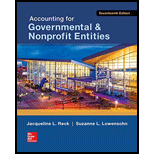
Accounting for Governmental & Nonprofit Entities
17th Edition
ISBN: 9780078025822
Author: Jacqueline L. Reck James E. Rooks Distinguished Professor, Suzanne Lowensohn, Earl R Wilson
Publisher: McGraw-Hill Education
expand_more
expand_more
format_list_bulleted
Question
Chapter 11, Problem 19.5EP
To determine
Find the correct option, the option that indicates an additional standard imposed by GAGAS (generally accepted government auditing standards), compared to GAAS (generally accepted accounting standards).
Expert Solution & Answer
Want to see the full answer?
Check out a sample textbook solution
Students have asked these similar questions
Tommys so books on leo July 21 year-end. The company does make eerless crue for Inverses ancage de ke year-end. On June 30, 2007, the Recall cours kolonce à 304,400 Now Reclude she folowing
Dute
Maker Face Value
Tar
Maturity Data R
Apt C
85,000 90 day
July 20
May 15 ya
7,000
July24
Car
10,000 December
During Julhe following recom
July Modes of $4,300 on Toorak edece
165700 un Vrede cord. The cred card recharge la 26.
20 Recall
24
(a)
Journalize the July wonde July designery for ccrued in recevable coming 250 days for exams.com of goods sold edit account titles are automatically indented when amo
Account Titles and Explanation
Date
Debit
Credit
Textbook and Media
List of Accounta
Based on the screenshot, what is the shortest path and duration?
Based on the screenshot, what is the maximim flow?
Chapter 11 Solutions
Accounting for Governmental & Nonprofit Entities
Ch. 11 - Prob. 1QCh. 11 - Prob. 2QCh. 11 - Prob. 3QCh. 11 - Prob. 4QCh. 11 - Prob. 5QCh. 11 - Prob. 6QCh. 11 - Prob. 7QCh. 11 - Prob. 8QCh. 11 - Prob. 9QCh. 11 - Prob. 10Q
Ch. 11 - Background. Lake View Mental Health Affiliates, a...Ch. 11 - Prob. 12CCh. 11 - Prob. 13CCh. 11 - Prob. 14CCh. 11 - Prob. 15CCh. 11 - Prob. 16CCh. 11 - Prob. 17CCh. 11 - Prob. 19.1EPCh. 11 - Prob. 19.2EPCh. 11 - Prob. 19.3EPCh. 11 - Prob. 19.4EPCh. 11 - Prob. 19.5EPCh. 11 - Prob. 19.6EPCh. 11 - Prob. 19.7EPCh. 11 - Prob. 19.8EPCh. 11 - Prob. 19.9EPCh. 11 - Prob. 19.10EPCh. 11 - Prob. 21EPCh. 11 - Prob. 22EPCh. 11 - Prob. 23EP
Knowledge Booster
Similar questions
- I want question answer financial accountingarrow_forwardForeign currency remeasurement—Total assets A U.S.-based parent company acquired a European Union–based subsidiary many years ago. The subsidiary is in the service sector, and earns revenues and incurs expenses evenly throughout the year. The following preclosing trial balance includes the subsidiary’s original Euros-based accounting information for the year ended December 31, 2022, immediately prior to closing the company’s nominal accounts into the corresponding balance sheet accounts. It also includes the information converted into $US based on the indicated exchange rates: $US Conversion Weighted- Debits (Credits) Euros Current Average Historical Monetary Assets € 180,000.00 $216,000 $221,400 $234,000 Nonmonetary assets 720,000 864,000 885,600 936,000 Monetary Liabilities (90,000) (108,000) (110,700) (117,000) Nonmonetary liabilities (450,000) (540,000) (553,500) (585,000) Contributed capital (216,000) (259,200) (265,680) (302,400) Retained earnings…arrow_forwardForeign currency remeasurement—Stockholders’ equity A U.S.-based parent company acquired a European Union–based subsidiary many years ago. The subsidiary is in the service sector, and earns revenues and incurs expenses evenly throughout the year. The following preclosing trial balance includes the subsidiary’s original Euros-based accounting information for the year ended December 31, 2022, immediately prior to closing the company’s nominal accounts into the corresponding balance sheet accounts. It also includes the information converted into $US based on the indicated exchange rates: $US Conversion Weighted- Debits (Credits) Euros Current Average Historical Monetary Assets € 160,000.00 $192,000 $196,800 $208,000 Nonmonetary assets 640,000 768,000 787,200 832,000 Monetary Liabilities (80,000) (96,000) (98,400) (104,000) Nonmonetary liabilities (400,000) (480,000) (492,000) (520,000) Contributed capital (192,000) (230,400) (236,160) (268,800) Retained…arrow_forward
- ? ? Financial accounting questionarrow_forwardThe income statement of a merchandising company includes Cost of Goods Sold (COGS) and gross profit, which are not found on a service company’s income statement. This is because merchandising companies sell physical products, while service companies provide intangible services. Service company income statements are simpler, usually showing revenue from services minus operating expenses like salaries, rent, and supplies. In short, the main difference is that merchandising firms track product costs and gross profit, while service companies do not. Respond to this post. agree or disagreearrow_forwardPlease give me true answer this financial accounting questionarrow_forward
- Financial accounting questionarrow_forwardPlease solve and show work for general accounting questionarrow_forwardCarlisle Manufacturing, which uses a calendar year, purchased a machine for $60,000 on January 5, 2015. It estimates the machine will have a useful life of 10 years and a $6,000 residual value. The machine is expected to produce 250,000 units during its useful life. The actual number of units produced were 22,000 during 2015, 31,000 during 2016, 24,000 during 2017, and 30,000 during 2018. Using the straight-line method, what is the book value at December 31, 2017?arrow_forward
arrow_back_ios
SEE MORE QUESTIONS
arrow_forward_ios
Recommended textbooks for you
 Auditing: A Risk Based-Approach (MindTap Course L...AccountingISBN:9781337619455Author:Karla M Johnstone, Audrey A. Gramling, Larry E. RittenbergPublisher:Cengage Learning
Auditing: A Risk Based-Approach (MindTap Course L...AccountingISBN:9781337619455Author:Karla M Johnstone, Audrey A. Gramling, Larry E. RittenbergPublisher:Cengage Learning Auditing: A Risk Based-Approach to Conducting a Q...AccountingISBN:9781305080577Author:Karla M Johnstone, Audrey A. Gramling, Larry E. RittenbergPublisher:South-Western College Pub
Auditing: A Risk Based-Approach to Conducting a Q...AccountingISBN:9781305080577Author:Karla M Johnstone, Audrey A. Gramling, Larry E. RittenbergPublisher:South-Western College Pub

Auditing: A Risk Based-Approach (MindTap Course L...
Accounting
ISBN:9781337619455
Author:Karla M Johnstone, Audrey A. Gramling, Larry E. Rittenberg
Publisher:Cengage Learning

Auditing: A Risk Based-Approach to Conducting a Q...
Accounting
ISBN:9781305080577
Author:Karla M Johnstone, Audrey A. Gramling, Larry E. Rittenberg
Publisher:South-Western College Pub
